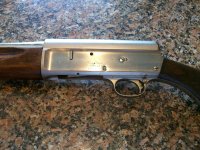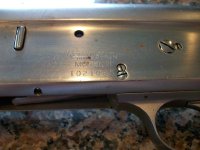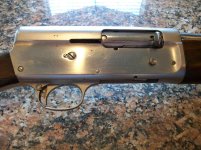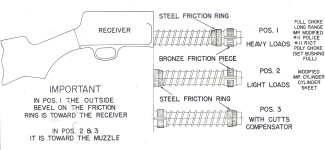You are using an out of date browser. It may not display this or other websites correctly.
You should upgrade or use an alternative browser.
You should upgrade or use an alternative browser.
WTK: Remington Model 11, mfg date, worth
- Thread starter AZG3
- Start date
Jeff Mulliken
New member
There is no classic American made shotgun that can be had for so little money as the Model 11. So many of the fans of the humpback guns focus on the Auto-5 that the M11's sit and wait for a buyer.... And Remingtom made millions and millions of them.
So if you want a "classic" in your rack and only have a couple hundred bucks start looking for one. Most were used hard and long so dont expect to buy a NIB gun. A lot of finish wear is ok and to be expected but don't pick up a broken down one with pitting, a bad recoil pad and a cut off barrel.
Wait till you see one that shows plenty of use and NO abuse then get out your wallet.
Jeff
So if you want a "classic" in your rack and only have a couple hundred bucks start looking for one. Most were used hard and long so dont expect to buy a NIB gun. A lot of finish wear is ok and to be expected but don't pick up a broken down one with pitting, a bad recoil pad and a cut off barrel.
Wait till you see one that shows plenty of use and NO abuse then get out your wallet.
Jeff
Original Model 11
I own a post 1932 Model 11 (12 Gauge), that has very little wear from when it was originally purchased. There is some small markings on the barrel, minor damage to the hand stock, the original glow site (I believe), and original rubber butt. Since it was hardly used (I've owned for at least 20 years and have never fired it), I'm assuming it has all the original parts in fairly new condition. I belive the serial number is in the 425xxx range. Is that the number on the left side, below the word "Remington?"
I own a post 1932 Model 11 (12 Gauge), that has very little wear from when it was originally purchased. There is some small markings on the barrel, minor damage to the hand stock, the original glow site (I believe), and original rubber butt. Since it was hardly used (I've owned for at least 20 years and have never fired it), I'm assuming it has all the original parts in fairly new condition. I belive the serial number is in the 425xxx range. Is that the number on the left side, below the word "Remington?"
Last edited:
My father owned a Mod 11 riot gun with military markings. He had a Cutts Compensator installed, and I shot a bunch of doves and a few ducks with that old gun. He bought it "new" in cosmoline during the 1960's. Later sold the gun (in pristine condition) to a nearby Sheriff's Dept. Wish I could find that old piece!
It has a round firing pin. Where on the barrel would I find the letter?
I see I forgot to say it has the "Checkered Stocks" and it's a 12 Gauge (added to original post).
Do they all have the flying duck on the left side and a pheasant on the ground, on the right side?
I've also run across some information about setting up the friction rings for different ammo and find that the information about the steel friction ring doesn't jive with the one I have. It notes that it's very important to install this ring correctly, but the bevel on mine is on the inside of the ring and not on the outside.
Do I measure the complete length of the barrel for length or is there some point along the assembly that I stop at? How do I tell if it's plain or matted rib barrel?
I see I forgot to say it has the "Checkered Stocks" and it's a 12 Gauge (added to original post).
Do they all have the flying duck on the left side and a pheasant on the ground, on the right side?
I've also run across some information about setting up the friction rings for different ammo and find that the information about the steel friction ring doesn't jive with the one I have. It notes that it's very important to install this ring correctly, but the bevel on mine is on the inside of the ring and not on the outside.
Do I measure the complete length of the barrel for length or is there some point along the assembly that I stop at? How do I tell if it's plain or matted rib barrel?
Last edited:
I know it took me a while, but here are some poor photos of the Model 11 I inherited which I believe is stainless. Let me know of you think this is some type of finish rather than stainless. Thanks.
Attachments
Friction Ring Type
as Rem#11 observed the FRICTION RING is different than shown in the instructions. his (and mine) are just cylinders (about 3/16~1/4 thick) on the exterior and have a bevel on the inside (one end only). the instructions show a FRICTION RING that has a cylindrical section and a conical section (external) on one end. the instructions are VERY specific on which direction the 'OUTSIDE BEVEL' faces depending on the load you are setting the gun up for. i (and probably Rem#11) would greatly appreciate knowing which way OUR FRICTION RINGS should be assembled. attached are the instructions i refer to above. thanks for any help.
as Rem#11 observed the FRICTION RING is different than shown in the instructions. his (and mine) are just cylinders (about 3/16~1/4 thick) on the exterior and have a bevel on the inside (one end only). the instructions show a FRICTION RING that has a cylindrical section and a conical section (external) on one end. the instructions are VERY specific on which direction the 'OUTSIDE BEVEL' faces depending on the load you are setting the gun up for. i (and probably Rem#11) would greatly appreciate knowing which way OUR FRICTION RINGS should be assembled. attached are the instructions i refer to above. thanks for any help.
Attachments
Techsan-
Someone has refinished your Model 11 in nickel. It should be very durable, but it is not original.
jhp-jcp-
The ring you are describing is a friction ring. If the bevel is on the inside, you have a Browning A5 friction ring. Friction pieces are made of bronze with a spring steel band around the outside and are used under the friction ring when firing heavy loads. Do not fire the shotgun without friction pieces as it causes the barrel extension to bottom out in the receiver, possibly damaging it. You can use Browning A5 friction pieces. Numrich Arms has some parts for your shotgun.
http://www.e-gunparts.com/DisplayAd.asp?chrProductSKU=55820-01A&chrSuperSKU=55820-01&MC=
Someone has refinished your Model 11 in nickel. It should be very durable, but it is not original.
jhp-jcp-
The ring you are describing is a friction ring. If the bevel is on the inside, you have a Browning A5 friction ring. Friction pieces are made of bronze with a spring steel band around the outside and are used under the friction ring when firing heavy loads. Do not fire the shotgun without friction pieces as it causes the barrel extension to bottom out in the receiver, possibly damaging it. You can use Browning A5 friction pieces. Numrich Arms has some parts for your shotgun.
http://www.e-gunparts.com/DisplayAd.asp?chrProductSKU=55820-01A&chrSuperSKU=55820-01&MC=
Last edited:
Yes, the Friction Ring
ok, my question remains - how is this Friction Ring orientated? where do you put it for heavy/light loads? is the A5 Friction ring ok to use in the Model 11? as illustrated in the drawing i attached to my original post the model 11 Friction Ring is quite different than the A5 Ring. i already ordered one from Numrich thinking/hoping it will be the style with the bevel on the outside. there wasn't a picture but it was only $8.30 so what the heck. any help would be appreciated. thanks
ok, my question remains - how is this Friction Ring orientated? where do you put it for heavy/light loads? is the A5 Friction ring ok to use in the Model 11? as illustrated in the drawing i attached to my original post the model 11 Friction Ring is quite different than the A5 Ring. i already ordered one from Numrich thinking/hoping it will be the style with the bevel on the outside. there wasn't a picture but it was only $8.30 so what the heck. any help would be appreciated. thanks
Jackaldrummer
Inactive
hi everyone, i just registered and i have two questions. i just was recently gifted a Remington Autoloading Shotgun with the SN: 114XXX and was wondering if anyone could tell me the date? and i was going to clean my mechanism up and leave everything else be, would it hurt if i steel wooled the rust off the barrel or would that drop the value?
Jackaldrummer, I see you're new. Welcome to the forum. There are lots of knowledgeable people on this forum who should be able to help you with your question - if they see it. I mention this because it looks like this particular thread has just about breathed its last breath. I suggest you open a new thread with your question. Just go back to the SHOTGUN FORUM, open it and look for the place entitled NEW THREAD. Click on that, think of a title for your new thread and then ask your question. That'll get everybodys attention and you'll probably get your answer.
Remington Model 11
Reading about the Model 11 got me to wondering about the one I own. My father gave me this shotgun when I was a teenager. It was used for hunting pheasants and ducks for many years. I put it in the case some years ago and kept it in the closet.
The barrel has a Poly Choke on the end of it and has excessive rust. Can it be safely cleaned and used? The barrel is in good shape with no rust or pits, and the mechanics are clean.
Reading about the Model 11 got me to wondering about the one I own. My father gave me this shotgun when I was a teenager. It was used for hunting pheasants and ducks for many years. I put it in the case some years ago and kept it in the closet.
The barrel has a Poly Choke on the end of it and has excessive rust. Can it be safely cleaned and used? The barrel is in good shape with no rust or pits, and the mechanics are clean.
I own a Remington Model 11 and I know some of the history, etc. of that model, but I'm not the person to give you any advice worth taking on the rusty poly choke. There are people on this forum who can help you, but what you need to do is post a photo or two of your gun, showing the problem, if possible. Everybody loves to see pictures of Model 11s regardless of condition, and I'm sure someone will have some thoughts on what can be done.
PS. It wouldn't hurt to open a new thread with your question and the pictures.
PS. It wouldn't hurt to open a new thread with your question and the pictures.
I recently found and purchase a Model 11 in 20 gauge with a intergraded poly-choke at about NRA 70% from a local gunshop. My original intent was to chop the barrel to 18-1/8" making it a home defense gun. After only paying $212 (w/tax) I didn't think I could go wrong.
My thought was that this would be the "Ideal" house gun being recoil operated not gas. Since reading a number of the threads on this forum speaking out against such I'm not to sure? I didn't count on the importance of the barrel weight in the function of the action.
I've seen Model 11s shorten before for this purpose and know of the Model 11R that was originally manufactured with a 20" inch barrel. I've seen both modifications function just fine, but I've got a 20 gauge and I'm not sure that such modification would work as well seeing that we're talking about a lighter load in comparision to a 12 gauge.
I've got to admit I am a little confuse through? One post states that the internals would take a beating by lighting up the barrel, another states that it won't cycle if the barrel is lighten to much.
If it will beat the action then I would think that would be a simple fix by buying a Browning A-5 Magnum 20 springs and friction rings kit, if the latter then come up with a compensator that actually pushes the barrel to the rear.
Which is it?
By the way! Why is it that the Model 11 doesn't fetch a price closer to the Browning A-5? I can see that the wood and finish on the 11s isn't to the same level as the A-5s but one would think that the pricing would be some what closer then what it is seeing it's a near copy of the A-5s?
My thought was that this would be the "Ideal" house gun being recoil operated not gas. Since reading a number of the threads on this forum speaking out against such I'm not to sure? I didn't count on the importance of the barrel weight in the function of the action.
I've seen Model 11s shorten before for this purpose and know of the Model 11R that was originally manufactured with a 20" inch barrel. I've seen both modifications function just fine, but I've got a 20 gauge and I'm not sure that such modification would work as well seeing that we're talking about a lighter load in comparision to a 12 gauge.
I've got to admit I am a little confuse through? One post states that the internals would take a beating by lighting up the barrel, another states that it won't cycle if the barrel is lighten to much.
If it will beat the action then I would think that would be a simple fix by buying a Browning A-5 Magnum 20 springs and friction rings kit, if the latter then come up with a compensator that actually pushes the barrel to the rear.
Which is it?
By the way! Why is it that the Model 11 doesn't fetch a price closer to the Browning A-5? I can see that the wood and finish on the 11s isn't to the same level as the A-5s but one would think that the pricing would be some what closer then what it is seeing it's a near copy of the A-5s?
Last edited:
First, $212 for a usable Model 11 is a fair price.
Secondly, any long recoil action is a balancing act between getting the rings, springs, load and barrel weight synchronized. Changing anything drastically can badly affect reliability.
IME, most polychoked barrels on old autos are already bobbed a couple inches. And since I'm no fan of lopping off barrels, I'd see how this shot and functioned with say, 3 buck and the poly set on open.
New rings and springs are a good idea. Keep the old ones as spares.
HTH....
Secondly, any long recoil action is a balancing act between getting the rings, springs, load and barrel weight synchronized. Changing anything drastically can badly affect reliability.
IME, most polychoked barrels on old autos are already bobbed a couple inches. And since I'm no fan of lopping off barrels, I'd see how this shot and functioned with say, 3 buck and the poly set on open.
New rings and springs are a good idea. Keep the old ones as spares.
HTH....
Ive heard the same stories about Model 11's not recycling if their barrels are shortened and can't say its not true. But I know some outlaws back in the 1930's shortened model 11's fore and aft to make what were called "whippet guns". There's a famous photo of Bonnie Parker pointing one at Clyde Barrow. I believe one was taken from the Dillinger gang too. You'd figure that if these people had been unhappy with the result of their remodelling, they'd have tossed these guns and stolen something else.
I've also heard that Model 11's won't recycle properly if they're loaded with too light a load and that they should be adjusted (a "how-to-do-it" is availiable on-line) for the type of load you shoot. I'm wondering if you adjust your gun to its heaviest load setting (meaning most drams of powder, I think, not shot size) if that would compensate for a lighter weight barrel? Or do I have that backwards?
Why the difference in prices between A-5's and Remington Model 11s? Well, Remington Model 11's were not produced after 1947 while Browning A-5's continued to be produced until about 10 years ago (I think). So, the average age of Remington Model 11's for sale today is considerably older than the average age for A-5's, even though A-5's began production in 1902 and Remington Model 11's were produced from 1905. (Well, actually, the gun Remington produced on the John Browning patent from 1905-1910 was called The Remington Autoloading Shotgun; then it was tweaked a little and called the Remington Model 11 in 1911.) The oldest Model 11's are now reaching the 100 year old age that seperates "vintage" from "antique".. When these guns start being purchased as antiques instead of as firearms, I look for their value to increase. One things for sure. There's not much downside risk in buying a $211 gun that was designed by John Moses Browning, one of this country's greatest inventors, who considered this autoloading shotgun to have been his greatest achievement.
I've also heard that Model 11's won't recycle properly if they're loaded with too light a load and that they should be adjusted (a "how-to-do-it" is availiable on-line) for the type of load you shoot. I'm wondering if you adjust your gun to its heaviest load setting (meaning most drams of powder, I think, not shot size) if that would compensate for a lighter weight barrel? Or do I have that backwards?
Why the difference in prices between A-5's and Remington Model 11s? Well, Remington Model 11's were not produced after 1947 while Browning A-5's continued to be produced until about 10 years ago (I think). So, the average age of Remington Model 11's for sale today is considerably older than the average age for A-5's, even though A-5's began production in 1902 and Remington Model 11's were produced from 1905. (Well, actually, the gun Remington produced on the John Browning patent from 1905-1910 was called The Remington Autoloading Shotgun; then it was tweaked a little and called the Remington Model 11 in 1911.) The oldest Model 11's are now reaching the 100 year old age that seperates "vintage" from "antique".. When these guns start being purchased as antiques instead of as firearms, I look for their value to increase. One things for sure. There's not much downside risk in buying a $211 gun that was designed by John Moses Browning, one of this country's greatest inventors, who considered this autoloading shotgun to have been his greatest achievement.
edgraffiti
Inactive
Bumping an old thread in hopes you guys can help.
I have what I believe is a Remington Model 11 produced under the Browning patent. Serial Number is 21002.
I am trying to find out a manuf. date or even a value.
feel free to email me (replace @ for AT and . for DOT to block the spam bots)
edgraffiti AT yahoo DOT com
THANKS!
I have what I believe is a Remington Model 11 produced under the Browning patent. Serial Number is 21002.
I am trying to find out a manuf. date or even a value.
feel free to email me (replace @ for AT and . for DOT to block the spam bots)
edgraffiti AT yahoo DOT com
THANKS!
You'll find 2 letters on the left side of the barrel up close to where it meets the receiver and just above the forearm. This will be your date (month and year) of manufacturing, that is if the barrel is original to the rest of the gun. If the barrel is original to the gun you'll find the same number as is on the right side of the receiver on the bottom side of the barrel by the gas cylinder
Below is link to the chart with the code for dating. Hope this helps you out.
http://www.rc-trucks.org/remington-firearms-serial-numbers.htm
Here is another source that you can check with.
http://www.remingtonsociety.com/forums/viewtopic.php?f=7&t=4463
Below is link to the chart with the code for dating. Hope this helps you out.
http://www.rc-trucks.org/remington-firearms-serial-numbers.htm
Here is another source that you can check with.
http://www.remingtonsociety.com/forums/viewtopic.php?f=7&t=4463




